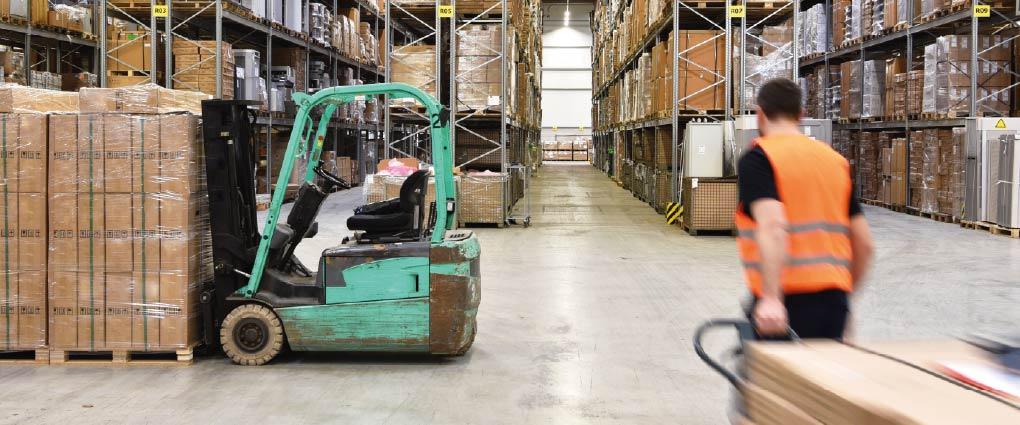Workplace accidents in the transport and storage sectors account for more than 260,000 cases annually (EU, 2022). Logistics warehouses, where pedestrians and forklifts circulate, are particularly affected. To prevent these accidents and provide the best possible protection for warehouse workers, the logistics company Sofrastock International, a subsidiary of the Renault Group, has opted for technological innovation. b<>com, the Renault Group via Software République, and Orange have developed and tested a solution to alert operators in the event of danger. Quick to deploy, even in challenging and changing environments, the application is based on location technologies using a simple camera. Jérôme Royan, VR, AR, AI Senior Scientist at b<>com, led the development and testing of the solution.
Jérôme, what problem were the logistics teams at Sofrastock International facing?
The logistics company SofraStock International manages a stock of automotive parts in one of its warehouses. Pedestrian handlers and forklift trucks operate in close proximity, with visibility sometimes limited or non-existent when the handler is working behind boxes, for example, and in a constantly changing environment. Unloading stations and arrival control areas are particularly prone to accidents, with heavy traffic flows leading to potential collision situations. It is in this context that SofraStock International and Renault Group's Software République wish to innovate to improve the safety of workers on site.
Several solutions have already been tested. They aimed to locate warehouse workers and forklifts to alert them to dangerous situations. However, this location tracking lacked precision, mainly due to metal shelving, which interfered with the radio signals used by these solutions. Furthermore, the deployment of these solutions requires the installation of numerous radio cells on the warehouse ceiling, which is costly.
To address this issue, what solution did you develop?
We developed a collision risk detection application in collaboration with Renault Sofrastock and Orange Business Services, with support from Software Republic. Using simple mobile phone cameras attached to forklifts and warehouse workers, the application can accurately estimate their location, orientation, and speed. By cross-referencing this data with the reaction times of forklift operators and the braking distance of forklifts, the application identifies risky situations and issues audible and visual alerts. In a way, it is the equivalent of the anti-collision systems found in modern vehicles, but applied to logistics warehouses.
This technology is based on the b<>com *Overview* platform, our remote location solution.
You tested the application in a real-life situation. How did you proceed?
Three experiments were conducted to test and improve the application. The first step was to digitally scan in 3D a 4,000 m² unloading area, a hazardous environment. This 3D mapping step was completed in less than two hours, using only a mobile phone! Next, smartphones (acting as connected cameras for the experiment) were positioned on forklift operators and forklifts to assess the robustness and accuracy of the location tracking. The results were particularly satisfactory: accuracy of less than 15 cm, alert latency of 200 ms maximum, a system unaffected by metal shelving, requiring no infrastructure modifications, and functioning even when obstacles such as pallets or storage shelves are present between operators.
The next phase consists of designing a ruggedised connected camera with a battery life of more than 8 hours and incorporating a visual-inertial odometry component. This lightweight device, worn on the handler's shoulder or attached to the forklift, will replace the smartphones used during these initial tests. The development of this camera remains an essential step in the industrialisation of the solution.
New features are coming to the b<>com *Overview* platform, such as initial scanning of the environment using LiDAR sensors (faster and more accurate than with a smartphone), 3D reconstruction of the environment in the form of a dense 3D point cloud or a photo-realistic 3D representation (Gaussian Splatting), as well as recognition and localisation of the various equipment and objects present in the real environment. These new features will enable keeping the warehouse or factory's digital twin up to date and provide a real-time inventory solution.
What are the other industrial uses for this technology?
In this specific case, the solution meets a security need in warehouses. But it can be applied to other industrial use cases: navigation assistance for humans and autonomous robots, large-scale augmented reality for maintenance or assembly assistance, in-situ visualisation of factory IoT sensor data, and quality control.
Minimising workplace accidents is one of our priorities, and technological innovation is a key lever for achieving this. The experiments conducted with b<>com have been particularly conclusive: the specific constraints of a warehouse, with its flows and infrastructure, have been taken into account to create a practical and quick-to-install solution.
You wish to learn more about this application?
Contact our experts here.



